
The Burmese snakehead, Channa harcourtbutleri (Annandale, 1918) is here shown to be a good species, differing distinctly from the related C. gachua (with which it had been synonymised) in having a smaller postorbital head depth (30.9 - 35.0 %HL), a longer (33.2-34.0 % SL) and narrower (16.9-19.0 % SL) head, a generally darker body with a distinctly marbled throat, and the juveniles lacking an ocellus on the dorsal fin.
Taxonomy; Channa harcourtbutleri; valid species; Channidae.
Fishes of the genus Channa are freshwater predatory fishes found throughout South, East and Southeast Asia. The taxonomy of some of the species has not been well-studied; a general overview of the genus is provided by Ng & Lim (1990b). In his study on the fishes of Inle Lake (Southern Shan State) in Myanmar, Annandale (1918) described a new species of snakehead, Channa harcourtbutleri . The species was diagnosed as being allied to C. gachua ( Hamilton, 1822 ), but differing in the shape of the head and the size of the scales. Hora & Mukerji (1934) synonymised C. harcourtbutleri with C. gachua . Although many workers (e.g. Myers & Shapovalov, 1931; DeWitt, 1960; Alfred, 1966) have regarded Channa orientalis Bloch in Schneider, 1801 as a senior synonym of Channa gachua , it is quite clear that both are distinct species, with differences in feeding ecology (Moyle & Senanayake, 1984) and breeding behaviour (Ettrich, 1986) 1 . They, however, are very similar externally (see Ng & Lim, 1989,1990b) although immediately distinguished by C. orientalis missing pelvic fins. The taxonomy of C. gachua as presently understood is a complex problem as the species as recognised is very widely distributed, ranging from Iran to Taiwan and to Bali (Weber & de Beaufort, 1922; Coad, 1978; Ng & Lim, 1990b), and has a host of synonyms, viz., Ophiocephalus aurantiacus Hamilton, 1822 ; Ophicephalus marginatus Cuvier & Valenciennes, 1831 ; Ophicephalus limbatus Cuvier & Valenciennes, 1831 Ophicephalus coramota Cuvier & Valenciennes, 1831 ; Ophicephalus fuscus Cuvier & Valenciennes, 1831 ; Ophiocephalus montanus McClelland, 1842; Phylipnoides surakartensis Bleeker, 1849; Ophiocephalus kelaarti Günther, 1861 ; Ophiocephalus gachua var. basalis Günther, 1861 ; and Ophiocephalus guachua var. malaccensis Peters, 1868. Sparus vagabundus Hamilton in Hora, 1931 is another synonym of C. gachua , although it is a nomen nudum. Recently, the third author obtained a good series of specimens of a Channa gachua -like fish from Inle Lake. Comparison of these specimens with India and various parts of Southeast Asia showed that the Inle Lake specimens belong to C. harcourtbutleri , and that C. harcourtbutleri is not a synonym of C. gachua . The present note serves to revalidate C. harcourtbutleri Annandale, 1918, as a valid species, and discusses the differences between it and C. gachua .
The following abbreviations are used: HL = head length, SL = standard length. Measurements used follow those of Hubbs & Lagler (1947) and Ng et al. (1996) with the following addition: the inter-pelvic fin distance is measured between the base of the outer rays of the two pelvic fins. Lateral scales are counted from the first lateral line scale (at the preopercle), the transverse scales are counted from the base of the first dorsal fin ray towards the anal fin. Predorsal scales are counted from base of first dorsal ray (scale on which it is attached not counted) to first fused cephalic scale. Institutional codes follow those of Eschmeyer (1998).
(?) Ophiocephalus gachua (non Hamilton, 1822) Boulenger, 1899:199.
Ophiocephalus harcourt-butleri Annandale, 1918: 54, text fig. 2, pl. 2 fig. 7 (type locality: Myanmar, Inle Lake); pl. 4 figs. 16, 17; Hora, 1921: 208.
(?) Ophicephalus gachua (non Hamilton, 1822) - Hora & Mukerji, 1934: 135, fig. 3.
Ophiocephalus harcourtbutleri - Tint Hlaing, 1971: 517 (list).
Channa orientalis - Kottelat, 1989: 20 (in part); Talwar & Jhingran, 1991: 1019 (in part).
ZSI F9439/1, 1 ex., holotype, 46.8 mm SL; Myanmar: southern Shan State, Inle Lake; N. Annandale, date unknown. NRM 28413, 5 ex., 85.2-123.8 mm SL; Myanmar: Shan State, Nyaung Shwe district, Inle Lake, tributary stream S of Phaung Daw Oo (20°27'N 96°54'E); S. O. Kullander & F. Fang, 5 Mar 1994. NRM 28486, 1 ex., 110.0 mm SL; NRM 28515, 23 ex., 58.5-138.9 mm SL; Myanmar: Shan State, Nyaung Shwe district, Inle Lake, purchased from fishermen; S. O. Kullander, F. Fang & T.R. Roberts, 26 Feb 1994. ZRC 42557,2 ex., 51.9-91.0 mm SL; AMNH 217782, 1 ex.,47.6 rum SL; Myanmar: Southern Shan State, northwestern part of Inle Lake; R. Britz, 9 Feb 1996. ZRC 42556, 3 ex., 111.3-136.3 mm SL; AMNH 217839, 14 ex., 90.0-127.5 mm SL; 20.2-25.1 mm SL; Myanmar: Thanlwin River basin, N Inle Lake, NE corner; K.-E. Witte, 31 Mar 1996. CMK 15109, 5 ex., 96.8-111.7 mm SL; ZRC 43467, 40 ex., 63.9-158.8 mm SL; Myanmar: Shan State, Naungshwe market, fish from Inle Lake (20°39'43.2'N 96°55'51.6'E); H. H. Tan & N. Sivasothi, 26 Feb 1999. ZRC 43538, 12 ex., 44.0-67.0 mm SL; Myanmar: Shan State, Inle Lake at Mine Thauk canal (20°34'52.2'N 96°56'21.0'E); H. H. Tan & N. Sivasothi, 26 Feb 1999. ZSI F9440/1-9442/1, 5 ex., 39.8-45.6 mm SL; data as for holotype. ZSI F9443/1-F9450/1, 14 ex., 45.4-185.1 mm SL; Myanmar: southern Shan State, Heho; N. Annandale, date unknown. ZSIF9451/1, 2ex., 39.1-53.0 mm SL; Myanmar: southern Shan State, Thumakam (Hsamongkam); N. Annandale, date unknown.
Channa harcourtbutleri can be differentiated from its congeners by the following combination of characters: head distinctly flatter and less convex (postorbital depth 30.9-35.0 %HL), head length 33.2-34.0 % SL, head width 16.9-19.0 % SL, pelvic fins 2.3-3.0 % of inter-pelvic fin distance, and dorsum black to purplish-black.
Body elongate, cylindrical, tapering dorso-ventrally to tail; lateral line curves downward at scale 15-16. In %SL: predorsal length 35.0-37.4, preanal length 52.4-55.1, prepelvic length 36.6-39.2, prepectoral length 32.4-34.9, dorsalfin base 57.4-60.7, anal-fin base 40.9-43.5, pelvic-fin length 10.1-11.8, pectoralfin length 18.5-21.8, dorsal-caudal length 6.3-7.1, body depth at anus 14.6-18.3, depth of caudal peduncle 10.3-11.8, head length 33.2-34.0, head width 16.9-19.0, head depth at nape 16.4-17.2). Dorsal and lateral aspects of head conical (Figs. 3b , 3c ); snout sharply convex (Fig. 3a ). In % HL: snout length 16.6-19.9, interorbital distance 25.9-26.5, eye diameter 13.2-14.6, postorbital depth 30.9-35.0. Pelvic fins present; maximum length 2.3-3.0 % inter-pelvic fin distance. Fin rays: dorsal = 34-38 (mode 36), anal fin rays = 23-26 (mode 23), pelvic = 5-7 (mode 6), pectoral = 14-15 (mode 14), caudal = ii,7+8,ii. Scale counts: lateral = 44-45, transverse = 14; predorsal = 4; caudal = 11-12. Vertebrae = 12+30 (n=1), 14+30 (n=1), 15 + 28-30 (n=4) or 16+24-28 (n=6).
Dorsum of adults black to purplish-black, posterior part below lateral line sometimes with black oblique streaks on dark grey background; ventrum dirty white to grey, with scattered darker grey spots; throat with bluish spots and blotches on dark-grey background, appearing marbled (Fig. 3c ), Dorsal, caudal and anal fins purplish-black to dark grey, with yellow to orange border; pelvic fins grey to dark grey, with yellowish border; pectoral fins greyish, base with distinct black blotch (not often discernible in larger specimens with black body and dark-grey fins), fin with 2-5 semi-concentric black rings which are always broader and darker nearer the base. Colour of preserved specimens similar to colour in life except that dorsum appears deep black; bluish blotches on throat are paler; yellow or orange border on dorsal, caudal, anal, and pelvic fins are white.
 | Fig. 1: A collection example of Channa harcourtbutleri - ZRC 42556, 111.3 mm, Inle Lake Myanmar. In comparison with the juvenile life state of C. gachua, C. harcourtbutleri never has a ocellus. |
Juveniles with dorsum dark brown, gradually fading towards the ventrum to cream. Dorsal, anal and caudal fins dark brown with a white edge at the distal margins. Pectoral fins hyaline, with 2-5 transverse dark brown bands.
Annandale (1918: 54) in diagnosing C. harcourtbutleri , observed that it differed from C. gachua in 'the smaller scales on the head, the longer, narrower, less flattened head' . Hora & Mukerji (1934: 136) dismissed C. harcourtbutleri as a good species, briefly arguing that the characters used by Annandale (1918) to differentiate it from C. gachua were invalid when a large series of specimens were examined. Channa harcourtbutleri has not been regarded as a valid species since.
We have examined good series of specimens of C. gachua from India, Sri Lanka, Vietnam, Myanmar, Thailand, Malaysia, Singapore and Indonesia (only some of the material examined is listed here in order to save space), and tentatively conclude that they are conspecific, but we draw attention to the fact that we have observed slight differences between the different populations from different parts of South and Southeast Asia (e.g. the presence of many small black spots on the body of Indochinese specimens we examined which are not present in Indian and Sundaic specimens), which seems to indicate that more than one species is involved. In any case, without additional material to fully understand both inter- and intraspecific variation, we can only tentatively follow previous workers in considering all of the populations conspecific.
The most obvious difference between C. harcourtbutleri , and C. gachua s.l. must surely be the colour of adult specimens. Annandale (1918) did not specifically mention this as one of the distinguishing characters even though the colour is plainly evident in the specimens he examined. Annandale (1918: 55) recognised two colour forms of C. harcourtbutleri with his Form A apparently the adult coloration and Form B the juvenile coloration. Form A was described as the 'whole body and head and the greater part of the fins are almost uniformly black, the ventral surface being only slightly paler and a little mottled and the pectoral fins showing slight traces of transverse banding; a narrow margin of red or reddish-orange runs round the vertical and the caudal fins' . This agrees perfectly with the series of adults we examined. We note, however, that the colour of the dorsum as well as the caudal, dorsal and anal fins vary slightly from black to purplishblack, with the ventrum being dirty grey in C. gachua (and all the other nominal species synonymised with it), the body coloration varies from grey to greyishbrown, the ventrum being white to dirty white; and the anal, caudal and dorsal fins are iridescent green and blue with an orange edge (Ng & Lim, 1990b; Lee & Ng, 1991). In C. harcourtbutleri , the throat is marbled with distinct bluish and grey marks on a black background, and somewhat resembles the condition in C. melasoma ( Bleeker, 1851 ) and C. baramensis (Steindachner, 1901) (Ng & Lim, 1990a; Ng et al., 1996). In C. gachua the throat may appear somewhat marbled, but the patterning is never as distinct (Ng, 1989; Ng & Lim, 1990b). Form B was described as the 'head and body are gray to olivaceous, pale on the ventral surface and with incomplete dark shaped < markings on the side' . This colour pattern agrees with that we observed in the juvenile specimens of C. harcourtbutleri , we obtained, with the red or orange margin on the anal, caudal and dorsal fins less apparent. It is also pertinent to note that this colour pattern is similar to that observed for young C. gachua and to a certain degree, adults (Ng & Lim, 1989,1990b; Lee & Ng, 1991). In C. gachua , however, there is always an ocellus at the posterior rays of the dorsal fin of juvenile fish ( Fig. 2b ), which becomes more diffuse and obscure as the animal reaches adulthood. In C. harcourtbutleri , by contrast, there is never any trace of an ocellus on the dorsal fin at any stage of its life ( Fig. 2a ).
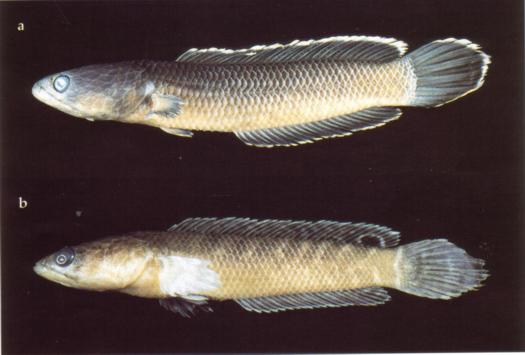 | Fig. 2: Collection examples of C. gachua. Example a - ZRC 41100, 107,7 mm SL, Perlis Malaysia; Example b - ZRC 41658, 46.5 mm SL, Kerala India. This (juvenile) example has an ocellus. |
We have examined fresh material collected from or near the type localities (Java for R surakartensis; Bengal for O. fuscus, O. gachua and O. aurantiacus; Sri Lanka for O. kelaarti) of most of the nominal species currently synonymised with C. gachua , with the exception of O. coramota , O. limbatus and O. montanus. With these exceptions, all of the other nominal species can be differentiated from C. harcourtbutleri , by a shorter and wider head (head length 26.8-31.9 % SL vs. 33.2-34.0; head width 18.6 - 21.7 % SL vs. 16.9-19.0) (Fig. 3b ); in the case of O. aurantiacus, this is supported by our examination of the figure provided with the original description ( Hamilton, 1822: pl. 23 fig, 22 ). Based on the descriptions of O. coramota and O. montanus, they are most likely to be conspecific with C. gachua as presently understood due to the fact that both these nominal species possess the light-brown or dark yellow body characteristic of C. gachua but not of C. harcourtbutleri . It is worth mentioning here that O. marginatus (with the French name Ophicéphale bordé) was described from both Pondicherry in southeastern India and Buitenzorg (=Bogor) in western Java, while the name O. limbatus (bearing the same French name as O. marginatus; this is possibly a typographical error) appears only on a figure (Cuvier & Valenciennes, 1831: pl. 201) based on a specimen from Java (M. Kottelat, pers. comm.). In any case, the figure of O. limbatus shows a species with a short (30.3 % SL) and wide (23.0 % SL) head typical of C. gachua . Ophicephalus gachua var. basalis was described from the 'East Indies'; in the original description, Günther (1861) mentioned that the juveniles have an ocellus at the posterior part of the dorsal fin, a character absent in C. harcourtbutleri (see below).
The character of the size of the cephalic scales used by Annandale to distinguish C. harcourtbutleri is rather doubtful at the moment, as it is known to vary not only with size but also sometimes within a population (Ng & Lim, 1991; Lee & Ng, 1994; Ng et al., 1996). The shape and proportions of the head, however, are very useful characters and are remarkably consistent (Ng & Lim, 1990b, 1991; Ng et al., 1996). This character can be used to separate C. harcourtbutleri and C. gachua easily, even for specimens of C. harcourtbutleri as small as 47.6 mm SL (AMNH 217782). When viewed laterally, the head of
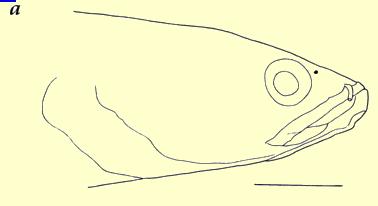 | Fig. 3a: Schematic drawing of C. harcourtbutleri (ZRC 42556, see Fig. 1) - lateral view. Scale bar: 10mm. |
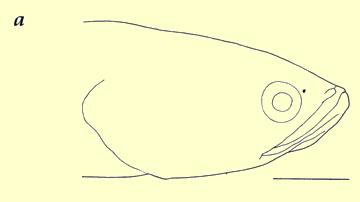 | Fig. 4a: Schematic drawing of C. gachua (ZRC 38909) - lateral view. Scale bar: 10 mm. |
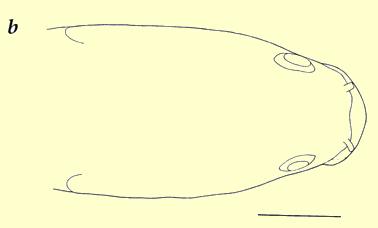 | Fig. 3b: Schematic drawing of C. harcourtbutleri (ZRC 42556, see Fig. 1) - dorsal view. Scale bar: 10 mm. |
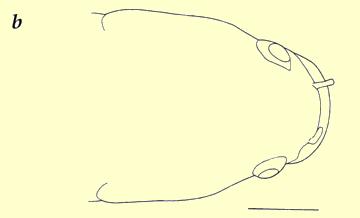 | Fig. 4b: Schematic drawing of C. gachua (ZRC 38909) - dorsal view. Scale bar: 10 mm. |
Boulenger (1893) reported Ophiocephalus gachua from 'Fort Stedman, 3000 feet', but his record is probably also based on C. harcourtbutleri . There is no evidence as yet that both C. harcourtbutleri and C. gachua occur together in Inle Lake. Channa gachua , however, is certainly also known from Myanmar, and Annandale (1918) himself accepted the Burmese record of the species. We have examined C. gachua from Myanmar (see list of comparative material), which agrees well with the species as currently understood. With regards to the record of C. harcourtbutleri from Manipur (Hora, 1921) and specimens attributed to C. gachua from the Southern Shan States (Hora, 1934), a re-examination of the specimens is clearly necessary to ascertain if his identification is correct.
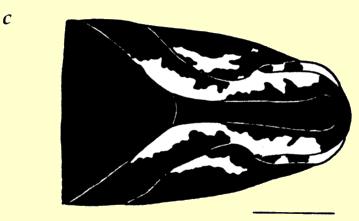 | Fig. 3c: Schematic drawing of C. harcourtbutleri (ZRC 42556, see Fig. 1) - ventral view. The marble ventral part of C. harcourtbutleri is besides the missing ocellus one of its main identification characteristics. Dead examples lose this feature, due to one of the authors. This means basically, that one hardly cannot differ these two species when dead in an adult stage. Scale bar: 10 mm. |
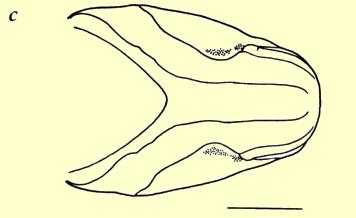 | Fig. 4c: Schematic drawing of C. gachua (ZRC 38909) - ventral view. |
Annandale (1918) noted that C. harcourtbutleri was not confined to Inle Lake but occurred all over the Yawnghwe area and neighbouring areas. Their preferred habitat in Inle Lake seems to be a '...muddy bottom in sluggish streams ... hiding as a rule among weeds' . Most of the larger recently-collected specimens were from markets and no ecological data was available. The juvenile and subadult specimens collected were from among weeds in shallow water.
Channa gachua: ZRC 1570, 6 ex., 85.0-102.8 mm SL; India: Uttar Pradesh, Rihand Dam; K. S. Misra, 13 Dec 1947. ZRC 38909/ 4 ex., 100.3-112.1 mm SL; India: aquarium trade; H.H. Tan, May 1995. ZRC 41658, 2 ex., 39.1-46.5 mm SL; India: Kerala, 8 km downstream of Thonmalai Dam area; R. Pethiyagoda, 1992. ZRC 41662, 4 ex., 48.3-90.7 mm SL; Sri Lanka; R. Pethiyagoda, 1991. NRM 21543, 10 ex., 101.1-126.3 mm SL; China: Yunnan Province, Ying Jiang county, Irrawaddy River drainage, Ying Jiang market; S. 0. Kullander & F. Fang, 4 Apr 1995. AMNH 13768, 7 ex., 78168 mm SL; Myanmar: Hai Bum; H. C. Raven, I Mar 1935. AMNH 217828, 1 ex., 209 mm SL; Myanmar: Mandalay market; R Britz, 3 Feb 1996. NRM 27076, 2 ex., 91.6-93.5 mm SL; Myanmar: Shan State, Mu-Se district, Mu-Se, ca. 16 km SE of Ruili, artificial river arm of Shweli River (23°59'N 97°51'E); F. Fang & E.-M. Wang, 10 May 1993. ZRC 39525, 1 ex., 84.0 mm SL; Vietnam: Cuc Phuong National Park, stream approx. 16 km from gate; H. H. Ng & D. C. J. Yeo, 16 Sep 1997. ZRC 40800, 6 ex., 39.8-92.5 mm SL; Thailand: Chantaburi Province, downstream of Nam Tok Phliu (12°31'14.0' N 102°10'36.1'E); H. H. Tan et al., 14 Jan 1997. ZRC 41100, 1 ex., 107.7 mm SL; Malaysia: Perlis, stream approx. 3 km after UUM on Sintok-Padang Senai road (6°27'31.7'N 100°32'53.9'E); H. H. Ng et al., 19 Feb 1997. ZMB 5152, 2 ex., 58-62 mm SL; Singapore: Kranji River; Jagor, date unknown (syntypes of C. guachua malaccensis). ZRC 10001, 1 ex., 111.5 mm SL, Singapore: Nee Soon Swamp Forest; P. Ng & K. Lim; 31 Dec 1989. ZRC 38314, 4 ex., 42.7-93.9 mm SL; Sumatra: Riau, Pulau Bintan north; D. S. L. Chung et al., Sep 1994. ZRC 16715, 1 ex., 93.7 mm SL; Java: Surabaya; P. K. L. Ng, May 1991. ZRC 40138, 2 ex., 84.6-101.0 mm SL; Java: Bogor, tributary of Cipinang Gading, H. H. Tan & S. H. Tan, 10 Jul 1996. ZRC 38110, 1 ex., 84.1 mm SL; Borneo: Sarawak, Matang Wildlife Centre, small forest creek 100 kin beyond Sungai Rayu; M. Kottelat et al., 5 May 1994.
We thank M. Kottelat for critically reviewing the manuscript, B. Brown and M. Stiassny (AMNH), S. 0. Kullander (NRM), K. K. P. Lim (ZRC), H.-J. Paepke (ZMB) and A. K. Karmakar (ZSI) for permission to examine material under their care, K.-E. Witte for obtaining some of the specimens, and H. H. Tan and M. Hohloch for taking the photographs. This study was partially supported by RP 960314 to the first author from the National University of Singapore and by a Kalbfleisch Postdoctoral Fellowship from the American Museum of Natural History to the third author.
Alfred, E. R. 1966. The freshwater fishes of Singapore. Zool. Verh., 78:1-68.
Annandale, N. 1918. Fish and fisheries of the Inle Lake. Rec. Ind. Mus., 14: 33-64, pls. 1-4.
Bleeker, P. 1849. Bijdrage tot de kennis der Blennioiden en Gobioiden van der Soenda-Molukschen Archipel, met beschrijving van 42 nieuwe soorten. Verh. Batav. Genootsch. Kunst. Wet., 22: 1-40.
Bleeker, P. 1851. Vijfde bijdrage tot de kennis der ichthyologische fauna van Borneo, met beschrijving van eeinige nieuwe soorten van zoetwatervisschen. Nat. Tijds. Ned. Ind., 2:415-442.
Boulenger, G. A. 1893. List of the fishes collected by Mr. E. W. Oates in the Southern Shan States, and presented by him to the British Museum. Ann. Mag. Nat. Hist., Ser. 6, 12: 198-203.
Coad, B. W. 1978. Range extension for the snakehead Ophicephalus gachua Hamilton (Osteichthyes: Channidae) in Iran. J. Bombay Nat. Hist. Soc., 75: 500 - 501.
Cuvier, G. & A. Valenciennes. 1831. Histoire naturelle des poissons. Tome Septième . Levrault, Paris-Strasbourg. xxix + 531 pp., pls. 170-208.
DeWitt, H. H. 1960. A contribution to the ichthyology of Nepal. Stanford Ichthyol. Bull., 7: 63-88.
Günther, A. 1861. Catalogue of the Fishes in the British Museum. Vol. 3. Trustees of the British Museum , London. xxv + 586 pp.
Hamilton, F. 1822. An account of the fishes found in the River Ganges and its branches . Archibald Constable & Company, Edinburgh. vii+405 pp., p1s. 1-39.
Hora, S. L. 1921. Fish and fisheries of Manipur with some observations on those of the Naga Hills. Rec. Ind. Mus., 22: 165- 214, pls. 9-11.
Hora, S. L. 1931. Buchanan's ichthyological manuscript entitled 'Piscium Bengalae Inferioris Delineationes'. J. Asiat. Soc. Bengal, 27: 123-135.
Hora, S. L. & D. D. Mukerji. 1934. Notes on fishes in the Indian Museum. XXIL On a collection of fish from the S. Shan States and the Pegu Yomas, Burma. Rec. Ind. Mus., 36: 125-138.
Hubbs, C. L. & K. F. Lagler. 1947. Fishes of the Great Lakes region. Cranbrook Inst. Sci. Bull., 26: 1-186.
Kottelat, M. 1989. Zoogeography of the fishes from Indochinese inland waters with an annotated checklist. Bull. Zool. Mus., 12: 1-55.
Lacepède, B. G. E. 1801 Histoire naturelle des poissons. v. 3: i-lxvi + 1-558, Pls. 1-34.
Lee, P. G. & P. K. L. Ng. 1991. The snakehead fishes of the Indo-Malayan Region. Nat. Malays., 16:112-129.
Lee, P. G. & P. K. L. Ng, 1994. The systematics and ecology of snakeheads (Pisces: Osteichthyes: Channidae) in Peninsular Malaysia and Singapore. Hydrobiologia, 285: 59-74.
McClelland, J. 1842. On the fresh-water fishes collected by William Griffith, Esq., F. L. S. Madras Medical Service, during his travels under the order of the Supreme Government of India, from 1835-1842. J. Nat. Hist. Calcutta 2: 560-589.
Ng, H. H., S. H. Tan & P. K. L. Ng. 1996. Revalidation of Channa baramensis (Steindachner, 1901), a species of snakehead from northern Borneo. Sarawak Mus. J., 48: 219-226.
Ng, P. K. L. & K. K. P. Lim. 1989. Rediscovery of the Dwarf Snakehead, Channa gachua (Hamilton, 1822) (Channidae) in Singapore. Raffles Bull. Zool., 37: 172174.
Ng, P. K. L. & K. K. P. Lim. 1990a. The Black Snakehead, Channa melasoma (Bleeker, 1851) (Channidae): First record from Singapore. Raffles Bull. Zool., 38: 21-24.
Ng, P. K. L. & K. K. P. Lim. 1990b. Snakeheads (Pisces: Channidae): Natural History, Biology and Economic Importance . Pages 127-152 in L. M. Chou & P. K. L. Ng, eds. Essays in Zoology. Department of Zoology, National University of Singapore.
Ng, P. K. L. & K. K. P. Lim. 1991. The identity of Ophicephalus cyanospilos Bleeker from Sumatra, and a new record of Channa bankanensis (Bleeker) from Peninsular Malaysia (Pisces: Channidae). Raffles Bull. Zool., 39: 119-130.
Peters, W. C. H. 1868. Über die von Herrn Dr. F. Jagor in dem ostindischen Archipel gesammelten Fische. Monatsber. Akad. Wiss. Berlin, 1868:254-281,460-461.
Steindachner, F. 1901. Kükenthal's Ergebnisse einer zoologischen Forschungreise in den Molukken und Borneo. Fische. Abh. Senckenberg. Ges., 25: 408-464.
Talwar, P. K. & A. G. Jhingran. 1991. Inland fishes of India and adjacent countries. 2 Vols. Oxford and IBH Publishing Co., New Delhi. 1158 pp.
Tint Hlaing 1971. A classified list of fishes of Burma. Union Burma J. Life Sci., 4: 507-526.
1 Ettrich, Günther 1986. Fische voller Überraschungen. DATZ 86/7 pp. 289-293. Note of the publisher. Back
This article was originally published May 1999 under the same title as above in: Journal of South Asian Natural History ; vol 4. pp. 57-63; ISSN 1022-0828. Thank you Ralf Britz and Heok Hee Ng for kindly granting snakeheads.org to publish it on the Internet. The copyright of the photos in the article is with the authors.
| © 2001 - 2004 snakeheads.org | HOME of this page |